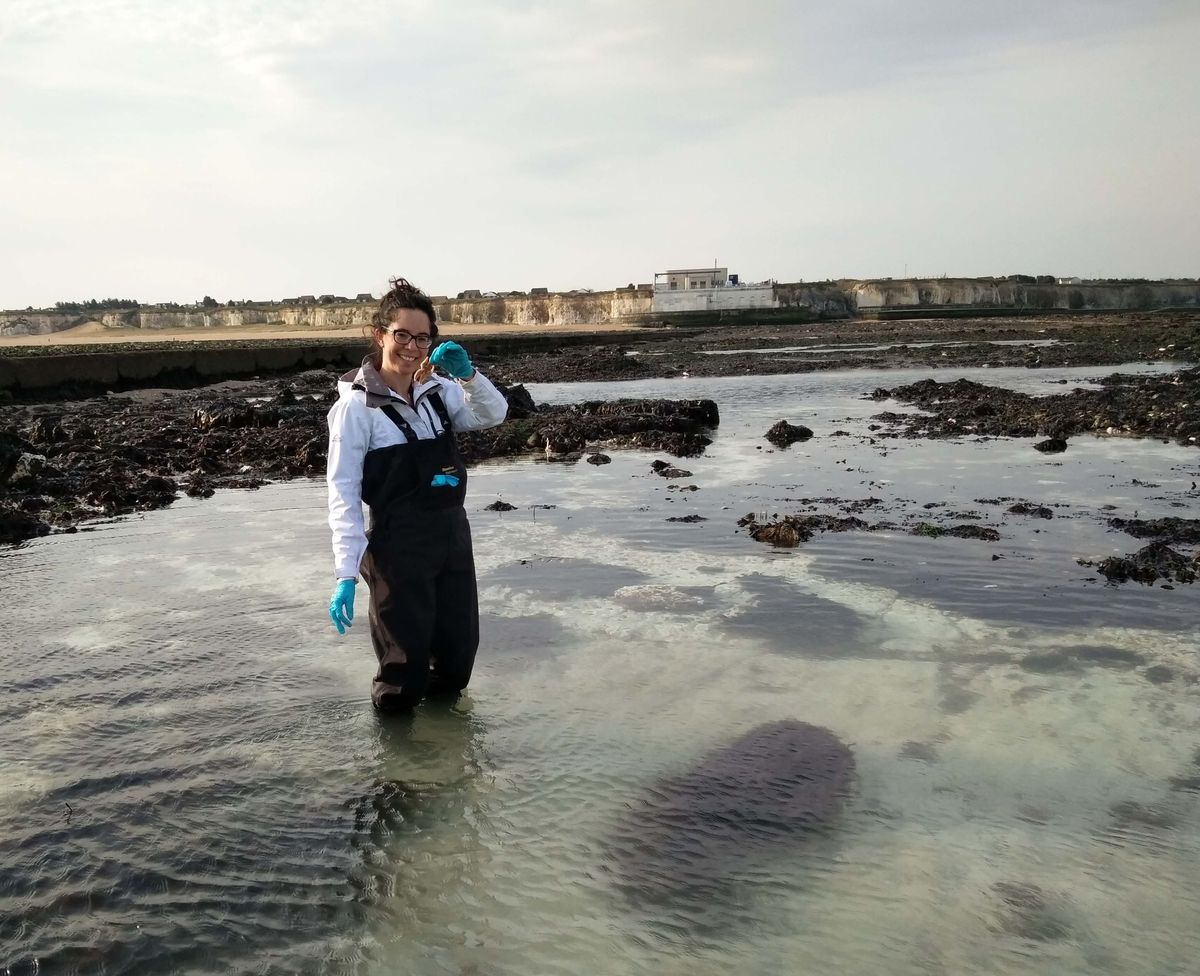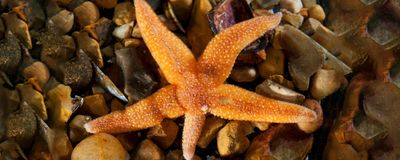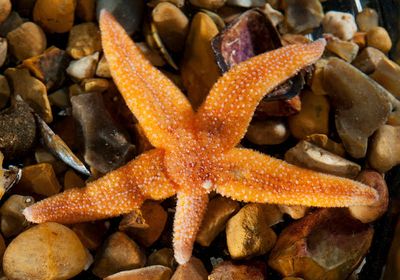ABOVE: Researchers have uncovered the mechanisms of autotomy by identifying a neurohormone that promotes arm loss in starfish. Maurice Elphick
Deep in the underwater world, animals like starfish use unusual ways to escape predators. In an act called autotomy, starfish shed one or more of their limbs to flee their hunters. The severed, writhing body part distracts the attacker, allowing the starfish to glide away. Over time, the starfish can even regenerate the lost limb, returning to their usual life after a brush with death.
This is not the only peculiar trait of these animals. “The feeding behavior of starfish [is] equally crazy and weird,” said Maurice Elphick, a physiologist and neurobiologist at Queen Mary University of London. These creatures squirt their stomach through their mouths, wrap it around food, and swallow the stomach back in once the food is digested.1 A few years ago, when Elphick and Ana Tinoco, a postdoctoral researcher in his lab, were studying this aspect of starfish behavior, they observed something intriguing. Injecting a digestion-associated neuropeptide into starfish caused some of the animals to shed their arms. Fascinated by this observation, they decided to investigate whether this molecule played a role in promoting self-amputation.
The team’s research, published in Current Biology, describes a neuropeptide—called Sulfakinin/cholecystokinin-type precursor protein, or ArSK/CCK1—that regulates arm detachment in the starfish Asterias rubens.2 This is the first neuropeptide identified as a modulator of autotomy in any animal.
Many animals like lizards, octopuses, crabs, and starfish can drop their body parts to escape from predators.3 According to Elphick, autotomy is so common in some species that his team regularly encounters starfish missing one or multiple arms when they collect these marine creatures along beaches. Despite the frequency of this limb loss, researchers do not fully understand the mechanisms and molecules involved in autotomy.

To build upon their initial observation, the researchers injected the neuropeptide at the base of an arm in more than 30 starfish. They found that five of the animals shed their limbs. In contrast, none of the animals injected with water showed a similar response.
Because ArSK/CCK1 injection did not induce autotomy in all the animals, the researchers hypothesized that this was not the only molecule involved in the response, said Elphick. “It's very rare that a complex process like shedding an arm would be controlled by just one molecule,” he added. “Maybe in the animals [in which ArSK/CCK1] did induce autotomy, perhaps they were already in a sort of stressed state,” he explained.
To test this hypothesis, the team stressed the starfish by using a mechanical clamp to exert pressure on starfish arms, mimicking an attack by a seagull or other predator. While clamping at the base of the arm resulted in autotomy in most of the animals, very few animals shed their limbs when they were clamped midway.
In contrast, injecting the neuropeptide into animals with arms clamped midway resulted in nearly 85 percent of the animals losing the pressured limbs. Almost half of the animals subjected to a combination of both mechanical clamping and ArSK/CCK1 injections also autotomized one or more other arms.
To investigate the physiological relevance of this neuropeptide, the researchers analyzed its expression at the base of the arm where autotomy occurs in A. rubens. Microscopy revealed that muscle-associated nerve fibers in this region expressed the neuropeptide even when the animals were not undergoing autotomy. This way, the neuropeptide is ready to be released when an appropriate stimulus triggers its secretion, Elphick explained.
His group has previously shown that this neuropeptide induces muscle contractions and inhibits feeding in A. rubens.4 However, the team observed that ArSK/CCK1 injection caused muscle constriction even in animals that did not shed their arms, suggesting that the neuropeptide may promote autotomy through additional mechanisms. Elphick speculates that the neuropeptide may be involved in softening and breaking tissues at the base of the starfish arm, which is an important step in autotomy.
Although he was initially surprised that this neuropeptide promoted autotomy, Elphick noted that, in retrospect, it is logical for a molecule that stops feeding to also stimulate arm shedding, since starfish are often attacked by predators mid-meal.
“It’s a really beautiful study,” said Emily Claereboudt, an echinoderm biologist at the University of Bergen. The dual mechanism in which physical and chemical stimuli come together to cause autotomy was surprising and interesting, she said. The results provide a deeper understanding of autotomy, which is the first step to regeneration. “So, understanding how autotomy can be triggered can expand the field of regeneration science.”
However, she added, the study could have provided a little more phylogenetic perspective. “It would be nice to have an idea of how widespread this peptide and its receptors [are].”
Elphick agreed. Pinpointing molecules involved in starfish regeneration can provide clues about similar molecules in humans, which may eventually translate into improving tissue regeneration, he said. But that would be a long-term goal. For now, he is excited about the results. “I hope this will inspire other people to think about this process in other animals and start to investigate the mechanisms.”
- Semmens DC, et al. Discovery of a novel neurophysin-associated neuropeptide that triggers cardiac stomach contraction and retraction in starfish. J Exp Biol. 2013;216(21):4047-4053.
- Tinoco AB, et al. Discovery of a neuropeptide that acts as an autotomy-promoting factor. Curr Biol. 2024;34(18):4325-4331.E3.
- Emberts Z, et al. The ecology and evolution of autotomy. Biol Rev. 2019;94(6):1881-1896.
- Tinoco Ab et al. Ancient role of sulfakinin/cholecystokinin-type signalling in inhibitory regulation of feeding processes revealed in an echinoderm. eLife. 10:e65667.




